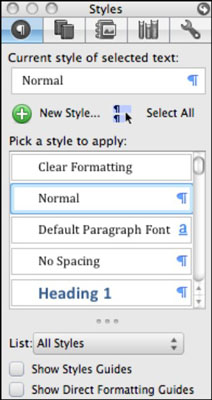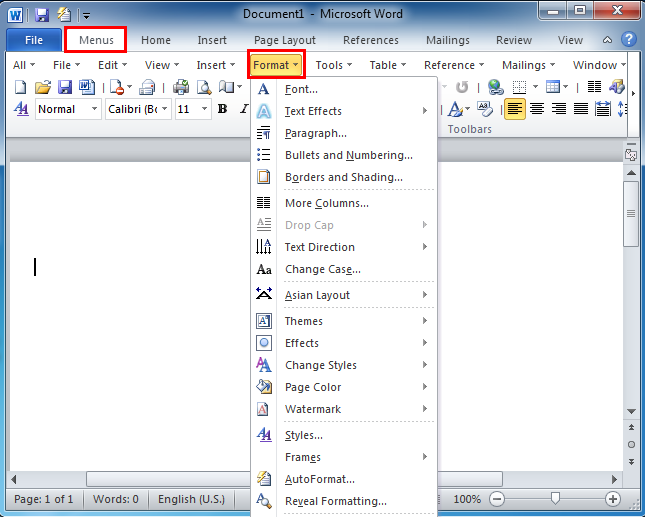
- #REVEAL FORMATTING IN WORD 2011 FOR MAC FULL#
- #REVEAL FORMATTING IN WORD 2011 FOR MAC SOFTWARE#
- #REVEAL FORMATTING IN WORD 2011 FOR MAC MAC#
- #REVEAL FORMATTING IN WORD 2011 FOR MAC WINDOWS#
Though paragraph and character styles are highlighted by Word in the Styles pane, Word never focuses on the style, so you have to scroll through a sometimes extensive list and find the highlighted one.I find this very powerful for a couple of reasons: The Style Inspector instantly shows you whichever paragraph and character styles are applied to your current cursor position, wherever you put your cursor.Amongst its many handy features, the following three stand out the most in day-to-day use. The Style Inspector is, without a doubt, the most useful tool when working with styles in Word. Style Inspector button in the Styles pane.

#REVEAL FORMATTING IN WORD 2011 FOR MAC MAC#
Enabling invisible characters (or hidden formatting marks) can be done by clicking the Show/Hide icon in the Paragraph group of the Home tab on both Mac and Windows. When working with another person’s Word files it is imperative to be able to see the underlying structure and identify extra hard returns, line breaks, multiple spaces, multiple tabs, and so on. But when working with other files I set up my workflow as follows. When writing, I usually start with a template and only use the Quick Styles area to apply headings as needed. In general, I use Word as a writing tool and for working with other people’s written files, either for troubleshooting or for adding additional structure. If it comes to the pure act of writing, the version really does not matter.
#REVEAL FORMATTING IN WORD 2011 FOR MAC WINDOWS#
As a result, Word for Windows is my go-to choice if I want to troubleshoot a Word file. Most notably for the way I work, the Mac version has no Style Inspector ( explained below), and no way to disable linked styles (to be addressed in a future article). The last few years have seen considerable effort on Microsoft’s behalf, and current versions are similar in many regards, but even today there are definitely some missing features. The Office Suite has had a Windows version and a Mac version for years, and in the beginning it really felt like the two applications came from different companies for their total lack of feature parity. Most notably storage and collaboration in the form of OneDrive and, recently, the “creative storytelling” tool Sway. Brilliant from an authoring perspective, but not nearly powerful enough for editorial work. Personally, I really like the online Word environment since it is not so ‘bloated’ with features that you don’t use.
#REVEAL FORMATTING IN WORD 2011 FOR MAC FULL#
They do not have the full functionality of a downloaded and installed version, but it is impressive what they do offer in their current versions. Like Google Docs, Office 365 offers what I would call ‘light’ versions of Word, PowerPoint, Excel, and OneNote, that work in the browser. Full versions of Microsoft Word for Windows, Microsoft Word for Mac, and Word for mobile devices, can be downloaded and installed from the Office 365 website.

#REVEAL FORMATTING IN WORD 2011 FOR MAC SOFTWARE#
When Microsoft made its move to the cloud back in 2011, they faced the same marketing problem that Adobe would face a year later: both companies were never able to fully dissipate the perception that the software would now only work in a browser. So, let’s dive right in! Office 365 vs Office Suite

I’ll also share a few ‘hidden gems’ that I use to set up my workspace for increased efficiency, and some tools that will enable you to get more out of Word’s many features. In this article, I want to address some general ‘nuggets of Word wisdom’, including the differences between Office 365 and Office Suite, and Word for Windows versus Word for Mac. And even if you are inclined to want to know something, sometimes the correct search terms fail you. There is often no time to investigate new ways of doing things. As with all things, we humble users are often pressed for time and use software the way we were taught-if we were lucky enough to have received formal training. However, the fact that something is the most-used application doesn’t necessarily mean that everyone is adept at using it. There is absolutely no doubt that Microsoft Word is the most-used word processing application on the planet, especially in corporate environments.Įven though I can’t back that statement up with some relevant statistical data or a beautiful infographic, I can definitely back it up with 20 years of experience dealing with the publishing industry! Guy van der Kolk Senior Solutions Consultant, Typefi


 0 kommentar(er)
0 kommentar(er)
